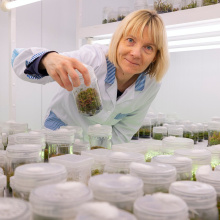
photo by Weronika Wojciechowska
The Polish Patent Office has granted two patents for innovative antibacterial agents to an interdisciplinary team of scientists from the Faculty of Chemistry and the Intercollegiate Faculty of Biotechnology UG and MUG.
The innovative solutions were developed at the Biologically Active Compounds Research Unit at the Intercollegiate Faculty of Biotechnology UG and MUG by dr Marta Krychowiak-Maśnicka and prof. dr hab. inż. Aleksandra Królicka in cooperation with dr Aleksandra Bielicka-Giełdoń from the Faculty of Chemistry UG.
The developed formulations, combining silver with naphthoquinones, effectively combat the bacteria Pseudomonas aeruginosa, which shows resistance to many antibiotics and causes difficult-to-treat infections in humans and animals, including wound infections.
The patents cover two inventions:
- a mixture of naphthoquinone and silver and the use of the mixture as an antimicrobial agent to combat Pseudomonas aeruginosa (patent no. 245017)
- a mixture of 5-hydroxy-2-methyl-1,4-naphthoquinone and silver preparations for use as an antibacterial agent to combat Pseudomonas aeruginosa (patent no. 245203).
The developed inventions exploit the synergistic phenomenon of silver and naphthoquinones, which takes a very interesting form in the case of P. aeruginosa, a bacterium that is resistant to many compounds, including naphthoquinones. A naphthoquinone with no antimicrobial activity against P. aeruginosa becomes activated in the presence of inactive doses of silver, resulting in effective control of this bacterium and a significant reduction in active doses of both substances.
The inventions developed may be particularly useful in the treatment of wounds, especially chronic wounds, where conventional antibiotics fail.
'The work on the inventions was a long-term process that began during my PhD,’ emphasises dr Marta Krychowiak-Maśnicka, who led the research. 'In the course of the research, we have developed formulations that not only effectively combat resistant bacteria, but also minimise the risk of resistance to the new agent. I am constantly working on further development of the synergy-based technology, including optimising the way the mixtures are administered. One of the biggest challenges is to optimise the composition of the mixtures to maximise the synergistic effect and effectively combat bacteria, while minimising toxicity to eukaryotic cells.'
Continuing their research, the scientists developed a formulation, combining naphthoquinone with a silver source, with potent antimicrobial activity, which was tested using an animal model of a wound. This research, which raises the technological level of the invention, was funded by the Technology Transfer Office at UG with funds from the ‘Innovation Incubator 4.0’ programme.
The process of intellectual property protection from invention application to obtaining patents was led by a team of specialists from the UG Technology Transfer Office.






